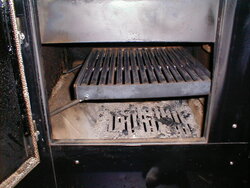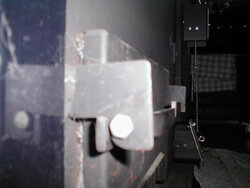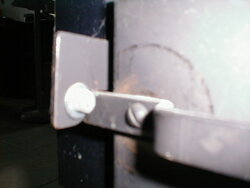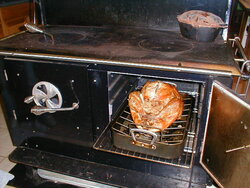Yes but how does the oven work in "summer mode?
No oven use with summer grate. The space under oven for exhaust flow is between the grates, so the fire would have to be downdraft through the upper grate to get around oven. The summer grate rests on folding rods for legs to fold for winter storage. I put a couple logs in and slide it across to install, it's that heavy.

That's a smoke flap at the top that swings inward for loading larger pieces if needed.
If the stove has been up to temp a while, the oven cruises around 350, so pulling the lever to circulate around it raises it depending on how much cold food you put in as well. It's like a freight train. When you see a large increase on the thermometer, you better close it down or shut the oven off or it's going to continue to climb far above what you want. It does not burn food like a modern oven if it gets too hot since it is sealed (other than a small vent hole) and moisture from the food prevents browning on top or burning. You get used to not browning casseroles in a wood oven no matter how hot you try it with. but meats are way juicier than a conventional vented oven.
The summer grate is identical to the winter one that lays low in the firebox. This is what makes the stove so easy to use, heat fast, or prolong a fire; The grate is made of steel rods with just the right amount of space between them that raking across will open the slots for bottom air from ash pan where the thermostat intake is to rush up through for intense oven heat or quick starts. Overnight it clogs with ash and the upper air intake through door is just like burning on a bed of ash. In the morning I toss a few small pieces in through the top (I never use the front loading door) and it takes right off. If it has burned way down, the long poker with a 90* bend on the end reaches down through the top to rake the grate rods sideways until a few hole appear to give it a burst of air from the bottom. This thing lights up like a light bulb in the morning with air from the bottom. I always crack the original intake through the front door to give it some secondary air above the fire and in the morning we only open the thermostat half way in case we get busy and it closes the air down as it comes up to temp, so the original intake becomes the low fire used much of the time.
I did a lot of research on many cookstoves and wanted one of these for years. I had a conversation with Duane about adding the thermostat which wasn't available to non-Amish at the time as well as upgrading the door thermometer to a probe type. You can see it in the pic above. I also changed all the galvanized screws to stainless inside and out. The gaskets are not cemented in place like most others, there is a groove that you tuck flat gasket into so the edge contacts the sealing surface. That's a nice feature that you can change a gasket while in operation if needed. Between adjustable hinges and latches, there were few improvements needed. The ash pan door and clean out cover on the back has a simple lever that as the gasket crushes, it can become loose, so I drilled a hole in the latch hook and made an eccentric washer on a 1/4-20 bolt to rotate the washer and be able to tighten the latch for gasket crush.
The only other improvement would be a "nest" for the lid over firebox for smaller pans. It takes a 11 inch round pan or kettle to cover that hole. (Hint - Hint Ed !)
Here's my latch adjuster;

Bolt head with shank close to hook edge.

Eccentric washer contacts latch instead of fixed position hook.





